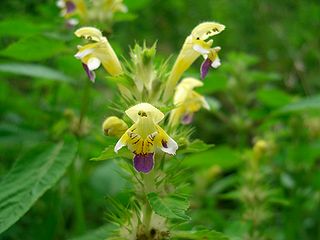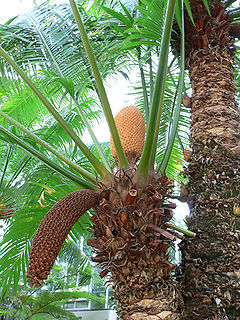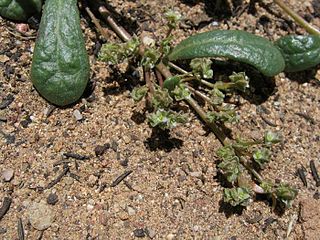
The Lamiales are an order in the asterid group of dicotyledonous flowering plants. It includes about 23,810 species, 1,059 genera, and is divided into about 24 families. Being one of the largest orders of flowering plants, Lamiales have representatives found all over the world. Well-known or economically important members of this order include lavender, lilac, olive, jasmine, the ash tree, teak, snapdragon, sesame, psyllium, garden sage, and a number of table herbs such as mint, basil, and rosemary.

A rose is a woody perennial flowering plant of the genus Rosa, in the family Rosaceae, or the flower it bears. There are over three hundred species and tens of thousands of cultivars. They form a group of plants that can be erect shrubs, climbing, or trailing, with stems that are often armed with sharp prickles. Their flowers vary in size and shape and are usually large and showy, in colours ranging from white through yellows and reds. Most species are native to Asia, with smaller numbers native to Europe, North America, and northwestern Africa. Species, cultivars and hybrids are all widely grown for their beauty and often are fragrant. Roses have acquired cultural significance in many societies. Rose plants range in size from compact, miniature roses, to climbers that can reach seven meters in height. Different species hybridize easily, and this has been used in the development of the wide range of garden roses.

The turnip or white turnip is a root vegetable commonly grown in temperate climates worldwide for its white, fleshy taproot. The word turnip is a compound of turn as in turned/rounded on a lathe and neep, derived from Latin napus, the word for the plant. Small, tender varieties are grown for human consumption, while larger varieties are grown as feed for livestock. In the north of England, Scotland, Ireland, Cornwall and parts of Canada, the word turnip often refers to rutabaga, also known as swede, a larger, yellow root vegetable in the same genus (Brassica).

A sporangium is an enclosure in which spores are formed. It can be composed of a single cell or can be multicellular. Virtually all plants, fungi, and many other lineages form sporangia at some point in their life cycle. Sporangia can produce spores by mitosis, but in nearly all land plants and many fungi, sporangia are the site of meiosis and produce genetically distinct haploid spores.

Selaginella is the sole genus of vascular plants in the family Selaginellaceae, the spikemosses or lesser clubmosses.

Cycads are seed plants that typically have a stout and woody (ligneous) trunk with a crown of large, hard, stiff, evergreen and (usually) pinnate leaves. The species are dioecious, that is, individual plants of a species are either male or female. Cycads vary in size from having trunks only a few centimeters to several meters tall. They typically grow very slowly and live very long, with some specimens known to be as much as 1,000 years old. Because of their superficial resemblance, they are sometimes mistaken for palms or ferns, but they are not closely related to either group.

The meristem is a type of tissue found in plants. It consists of undifferentiated cells capable of cell division. Cells in the meristem can develop into all the other tissues and organs that occur in plants. These cells continue to divide until a time when they get differentiated and then lose the ability to divide.

Basil, also called great basil, is a culinary herb of the family Lamiaceae (mints). It is a tender plant, and is used in cuisines worldwide. In Western cuisine, the generic term "basil" refers to the variety also known as sweet basil or Genovese basil. Basil is native to tropical regions from Central Africa to Southeast Asia. In temperate climates basil is treated as an annual plant, however, basil can be grown as a short-lived perennial or biennial in warmer horticultural zones with tropical or Mediterranean climates.

Phragmites is a genus of four species of large perennial reed grasses found in wetlands throughout temperate and tropical regions of the world.

Aldrovanda vesiculosa, commonly known as the waterwheel plant, is the sole extant species in the flowering plant genus Aldrovanda of the family Droseraceae. The plant captures small aquatic invertebrates using traps similar to those of the Venus flytrap. The traps are arranged in whorls around a central, free-floating stem, giving rise to the common name. This is one of the few plant species capable of rapid movement.

Caltha palustris, known as marsh-marigold and kingcup, is a small to medium size perennial herbaceous plant of the buttercup family, native to marshes, fens, ditches and wet woodland in temperate regions of the Northern Hemisphere. It flowers between April and August, dependent on altitude and latitude, but occasional flowers may occur at other times.

Calyptridium monandrum, synonym Cistanthe monandra, is a species of flowering plant in the family Montiaceae known by the common name common pussypaws.

A stem is one of two main structural axes of a vascular plant, the other being the root. It supports leaves, flowers and fruits, transports water and dissolved substances between the roots and the shoots in the xylem and phloem, stores nutrients, and produces new living tissue.

Calyptridium monospermum, synonym Cistanthe monosperma, is a perennial plant in the miner's lettuce family (Montiaceae), known by the common name one-seeded pussypaws. It was formerly classified in the purslane family (Portulacaceae).
Calyptridium pulchellum, synonym Cistanthe pulchella, is a rare species of flowering plant in the family Montiaceae. It is known by the common name mariposa pussypaws. It is endemic to the Sierra Nevada foothills of central California, where it is known from only a few scattered occurrences. It grows on barren patches of granite gravel in woodland and grasslands. It is a federally listed threatened species.

Calyptridium roseum, synonym Cistanthe rosea, is a species of flowering plant in the family Montiaceae commonly known as rosy pussypaws. It is native to the western United States from California to Wyoming, where it grows in forest and scrub. It is an annual herb, often reddish or pink in color, producing stems just a few centimeters long. The leaves are located in a rosette at the base and along the stems, and are up to 4 or 5 centimeters long. The inflorescence is a tiny cluster of white-edged thin sepals and two white petals, each no more than a millimeter long.

Calyptridium umbellatum, synonym Cistanthe umbellata, is a species of flowering plant in the montia family known by the common name Mount Hood pussypaws or — especially outside the Pacific Northwest — simply pussy-paws.

Myriophyllum verticillatum, the whorl-leaf watermilfoil or whorled water-milfoil, is a native to much of North America, North Africa, and Eurasia. It closely resembles another native milfoil, called northern water milfoil Whorled water milfoil is also easily confused with four types of invasive milfoils: Eurasian water milfoil, Variable water-milfoil, Parrot feather, and hybrid water milfoil.
Calyptridium pygmaeum, synonym Cistanthe pygmaea, common name pygmy pussypaws, is a plant species endemic to California. It has been reported from Riverside, San Bernardino, Inyo, Tulare and Fresno Counties, in pine and subalpine forests at elevations of 1900–3550 m.

Protea scabriuscula, also known as the hoary sugarbush or gray sugarbush, is a flowering shrub, endemic to the southwestern Cape Region of South Africa.

















